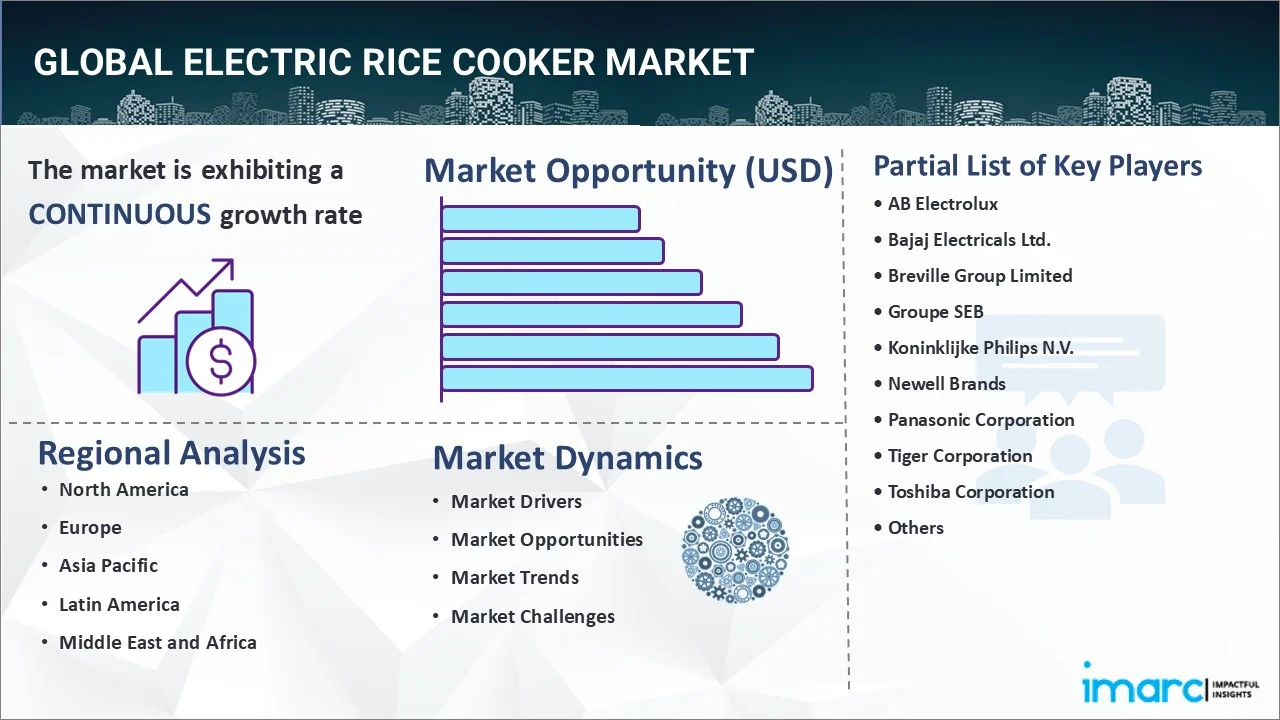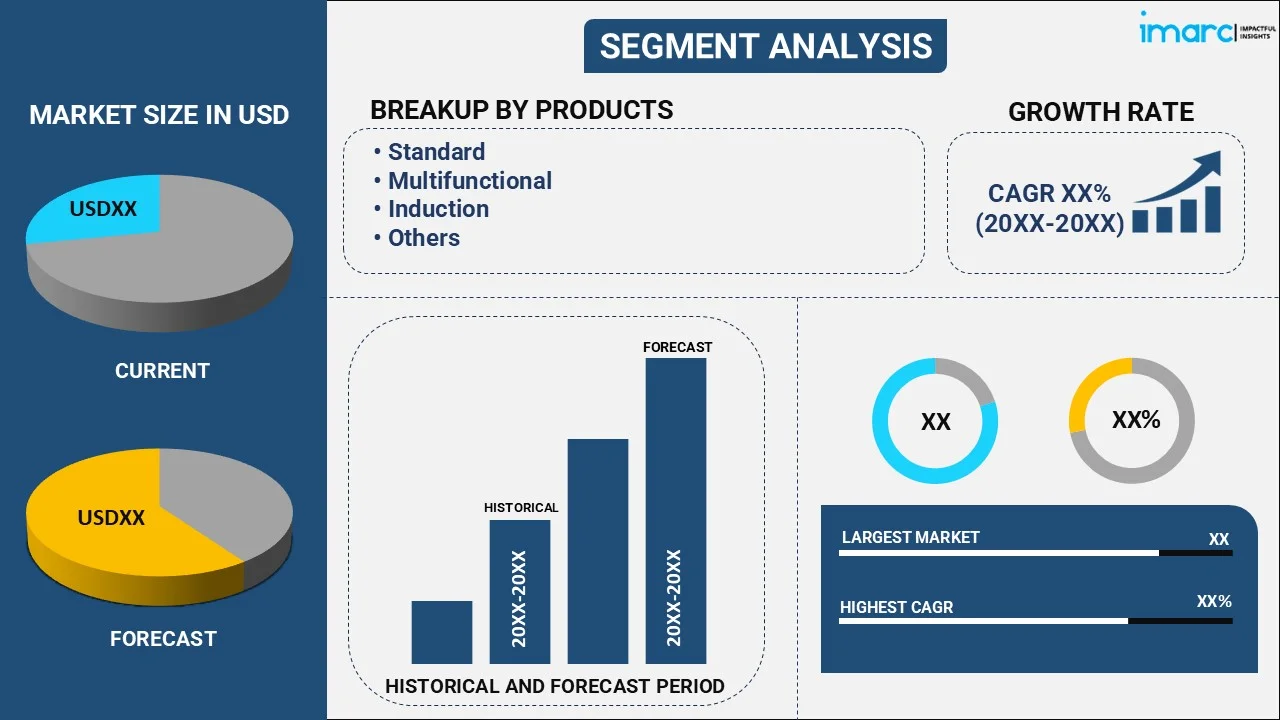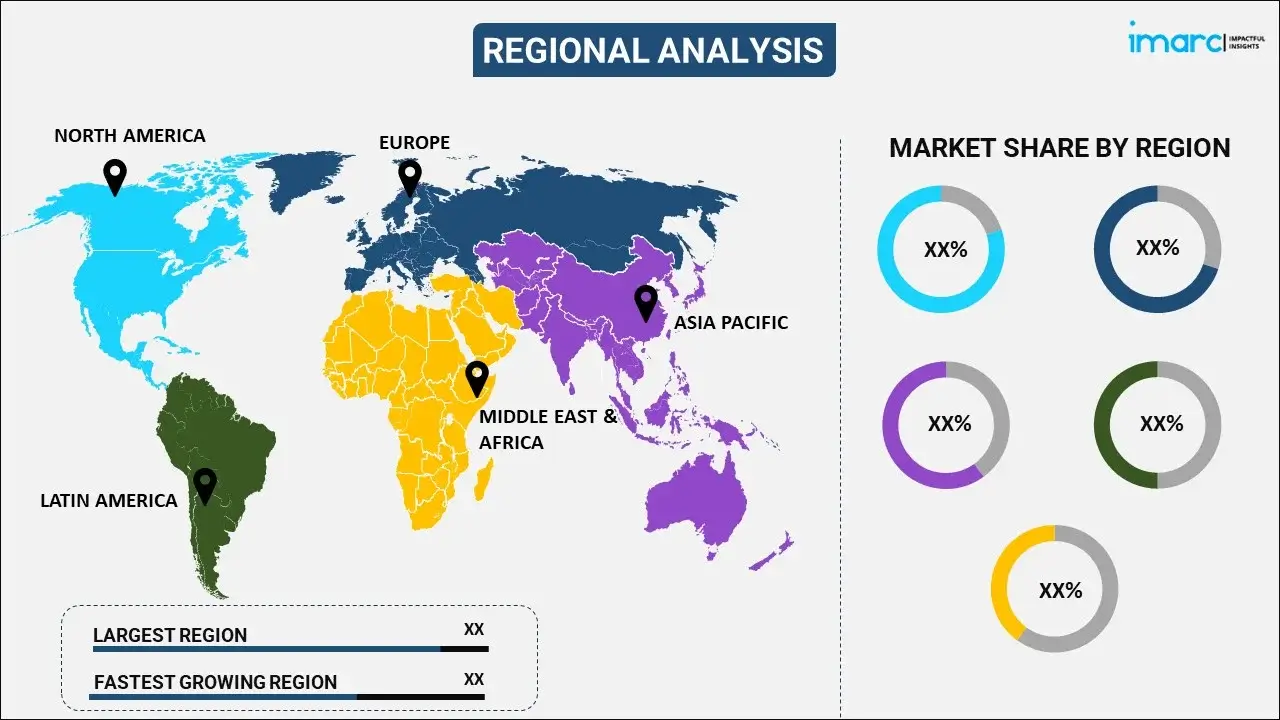
Electric Rice Cooker Market Report by Product (Standard, Multifunctional, Induction, and Others), Capacity (Small Volume, Medium Volume, Large Volume, Extra Large Volume), Distribution Channel (Supermarkets and Hypermarkets, Specialty Stores, Online Stores, and Others), End User (Household, Commercial), and Region 2025-2033
Market Overview:
The global electric rice cooker market size reached USD 4.4 Billion in 2024. Looking forward, IMARC Group expects the market to reach USD 6.8 Billion by 2033, exhibiting a growth rate (CAGR) of 5.1% during 2025-2033. The rising preference for healthy home-cooked meals, convenience offered by electric cookers in simplifying the cooking process, versatility of the product, and increasing popularity of Asian cuisines that includes rice dishes are some of the major factors propelling the market.
|
Report Attribute
|
Key Statistics
|
|---|---|
|
Base Year
|
2024
|
|
Forecast Years
|
2025-2033
|
|
Historical Years
|
2019-2024
|
|
Market Size in 2024
|
USD 4.4 Billion |
|
Market Forecast in 2033
|
USD 6.8 Billion |
| Market Growth Rate 2025-2033 | 5.1% |
An electric rice cooker is a kitchen appliance designed to simplify the process of cooking rice. It consists of a metal or non-stick inner pot, an outer shell, and a heating element. The user adds the desired amount of rice and water to the inner pot, and the cooker automatically regulates the cooking process. The heating element heats the pot, bringing the water to a boil and then reducing the heat to a simmer to cook the rice evenly. Once the rice is cooked, the cooker switches to a keep warm mode, maintaining the rice at an optimal temperature until it is ready to be served. Electric rice cookers eliminate the need for constant monitoring and provide consistent and fluffy rice with minimal effort.

One of the primary factors driving the market is the rising preference for healthy-home cooked meals. Electric rice cookers provide a hassle-free way to cook rice, encouraging individuals to include this as a staple food in their homemade meals. Moreover, rice cookers often feature settings for different types of rice, allowing users to customize their cooking experience. Additionally, electric rice cookers offer convenience by simplifying the rice cooking process. They eliminate the need for constant monitoring and stirring, allowing users to set the timer. This time-saving aspect resonates with busy individuals and households, making electric rice cookers an attractive kitchen appliance. Other than this, the increasing popularity of Asian cuisines, which prominently includes rice dishes, has gained widespread popularity globally. As people explore diverse culinary experiences, the demand for electric rice cookers has surged.
Electric Rice Cooker Market Trends/Drivers:
Rising Preference for Healthy Home-Cooked Meals
The rising preference for healthy home-cooked meals propels the electric rice cooker market by encouraging individuals to incorporate rice dishes into their diet. These cookers offer a convenient and hassle-free way to prepare rice, making it easier for health-conscious individuals to cook nutritious meals at home. With features, such as programmable settings and the ability to cook different types of rice, electric rice cookers cater to the specific needs of health-conscious individuals who seek control over their ingredients and cooking methods.
Convenience and Time Saving
Electric rice cookers offer a hassle-free and efficient way that simplify the cooking process and save time of individuals. With programmable settings and automated functions, users can set the desired cooking time and allows users to engage in other tasks while the rice cooks perfectly. The time-saving aspect is particularly appealing to busy individuals, working professionals, and families seeking quick and effortless meal preparation.
Increasing Popularity of Asian Cuisines
Electric rice cookers are designed to cook different types of rice commonly used in Asian cuisine, ensuring optimal texture and flavor. As more people explore and embrace diverse culinary experiences, the desire to replicate authentic Asian dishes at home is growing. The electric rice cooker becomes an essential tool to achieve consistent and delicious results, driving its adoption among individuals who want to enjoy Asian-inspired meals in their own kitchens, thereby contributing to the growth of the market.
Electric Rice Cooker Industry Segmentation:
IMARC Group provides an analysis of the key trends in each segment of the global electric rice cooker market report, along with forecasts at the global, regional, and country levels from 2025-2033. Our report has categorized the market based on product, capacity, distribution channel, and end user.
Breakup by Product:

- Standard
- Multifunctional
- Induction
- Others
Standard electric rice cookers represent the most popular product
The report has provided a detailed breakup and analysis of the electric rice cooker market based on the product. This includes standard, multifunctional, induction, and others. According to the report, standard electric rice cookers represented the largest segment.
Standard electric rice cookers provide a simple and affordable solution for cooking rice. These basic models provide essential features such as automatic cooking and keep-warm functions, making them accessible to a wide range of consumers. They appeal to individuals seeking a no-frills option for cooking rice without any additional complexities. The affordability and ease-of-use of standard electric rice cookers make them a popular choice for those looking for a straightforward and reliable cooking appliance.
Breakup by Capacity:
- Small Volume
- Medium Volume
- Large Volume
- Extra Large Volume
Small volume cookers dominate the market
A detailed breakup and analysis of the electric rice cooker market based on capacity has also been provided in the report. This includes small volume, medium volume, large volume, extra-large volume. According to the report, small volume rice cookers accounted for the largest market share.
Small volume electric rice cookers drive the market by catering to individuals or small households with lower rice consumption. These compact and portable models typically have a capacity of 1 to 3 cups of uncooked rice. They offer convenience for those who need to cook smaller portions, ensuring efficient rice preparation without wastage. Small volume electric rice cookers are popular among students, singles, or small families who value space-saving appliances and the ability to cook just the right amount of rice for their needs.
Breakup by Distribution Channel:
- Supermarkets and Hypermarkets
- Specialty Stores
- Online Stores
- Others
The majority of the electric rice cookers are distributed though supermarkets and hypermarkets
A detailed breakup and analysis of the electric rice cooker market based on the distribution channel has also been provided in the report. This includes supermarkets and hypermarkets, specialty stores, online stores, and others. According to the report, supermarkets and hypermarkets represented the largest segment.
Supermarkets and hypermarkets are large-scale retail stores that offer a wide range of products, including various models and brands of electric rice cookers. The convenience of one-stop shopping and the ability to compare different options side by side attract consumers seeking an electric rice cooker. Supermarkets and hypermarkets often provide competitive pricing, promotional offers, and discounts, making them an accessible and cost-effective avenue for consumers to purchase electric rice cookers, thus driving the market through increased visibility and availability.
Breakup by End User:
- Household
- Commercial
Household is the largest end user segment
A detailed breakup and analysis of the electric rice cooker market based on the end user has also been provided in the report. This includes household and commercial. According to the report, household accounted for the majority of the market share.
Electric rice cookers are mostly used in households, providing a convenient and efficient way to cook rice. With various sizes, capacities, and features available, electric rice cookers cater to the needs of individual households, small families, and large families alike. The desire for quick, hassle-free rice preparation, along with the growing popularity of diverse rice dishes in home cooking, contributes to the sustained demand for electric rice cookers among households, driving the market forward.
Breakup by Region:

- North America
- United States
- Canada
- Asia-Pacific
- China
- Japan
- India
- South Korea
- Australia
- Indonesia
- Others
- Europe
- Germany
- France
- United Kingdom
- Italy
- Spain
- Russia
- Others
- Latin America
- Brazil
- Mexico
- Others
- Middle East and Africa
Asia Pacific exhibits a clear dominance in the market, accounting for the largest electric rice cooker market share
The report has also provided a comprehensive analysis of all the major regional markets, which include North America (the United States and Canada); Europe (Germany, France, the United Kingdom, Italy, Spain, Russia, and others); Asia Pacific (China, Japan, India, South Korea, Australia, Indonesia, and others); Latin America (Brazil, Mexico, and others); and the Middle East and Africa. According to the report, Asia Pacific was the largest market for electric rice cookers.
Asia Pacific is a significant driver of the electric rice cooker market due to its rich culinary heritage and large population. The region's preference for rice-based dishes and the rising disposable incomes contribute to the growing demand for electric rice cookers. The convenience, time-saving features, and versatility of electric rice cookers align with the busy lifestyles of individuals in Asia Pacific. The expanding middle-class population and urbanization drive the market's growth as numerous households adopt electric rice cookers for their everyday cooking needs. Moreover, the strong cultural connection to rice consumption ensures the sustained demand for electric rice cookers in the region.
Competitive Landscape:
The key players invest in research and development (R&D) to innovate and introduce advanced features in their electric rice cooker models. This includes technologies like smart controls, programmable settings, and enhanced safety mechanisms. Additionally, key players focus on product differentiation by providing a diverse range of electric rice cooker models with varying capacities, sizes, and design aesthetics to cater to different consumer preferences. Marketing and promotional activities play a crucial role in driving the electric rice cooker market. Key players invest in advertising campaigns, digital marketing strategies, and partnerships with influencers to create brand awareness and reach a wider audience. They also engage in promotional offers, discounts, and attractive pricing strategies to attract customers and gain a competitive edge. Key players also prioritize distribution and retail partnerships to ensure wider availability of their products. They collaborate with supermarkets, specialty stores, and online platforms to reach consumers in various geographical locations. Strategic partnerships with retailers and e-commerce platforms help in expanding market reach and ensuring product visibility.
The report has provided a comprehensive analysis of the competitive landscape in the global electric rice cooker market. Detailed profiles of all major companies have also been provided. Some of the key players in the market include:
- AB Electrolux
- Bajaj Electricals Ltd.
- Breville Group Limited
- Groupe SEB
- Koninklijke Philips N.V.
- Newell Brands
- Panasonic Corporation
- Tiger Corporation
- Toshiba Corporation
- TTK Prestige Ltd.
- Wonderchef Home Appliances Pvt. Ltd.
- Zojirushi Corporation
Recent Developments:
- Koninklijke Philips N.V. launched a 5-layer Bakuhanseki coating rice cooker, which is six times harder than normal coatings. It ensures that the product lasts longer, and the 3D heating system delivers 360 degrees heat circulation.
- TTK Prestige Ltd. launched India’s first IoT-enabled rice cooker that can be controlled remotely by consumers through the prestige smart app in their mobile phones.
- Zojirushi Corporation launched Zojirushi NS-TSC10 micom rice cooker and warmer with easy-to-clean clear coated stainless-steel exterior and micro computerized fuzzy logic technology.
Electric Rice Cooker Market Report Scope:
| Report Features | Details |
|---|---|
| Base Year of the Analysis | 2024 |
| Historical Period | 2019-2024 |
| Forecast Period | 2025-2033 |
| Units | Billion USD |
| Scope of the Report | Exploration of Historical and Forecast Trends, Industry Catalysts and Challenges, Segment-Wise Historical and Predictive Market Assessment:
|
| Products Covered | Standard, Multifunctional, Induction, Others |
| Capacities covered | Small Volume, Medium Volume, Large Volume, Extra Large Volume |
| Distribution channels covered | Supermarkets and Hypermarkets, Specialty Stores, Online Stores, Others |
| End users covered | Household, Commercial |
| Regions Covered | Asia Pacific, Europe, North America, Latin America, Middle East and Africa |
| Countries Covered | United States, Canada, Germany, France, United Kingdom, Italy, Spain, Russia, China, Japan, India, South Korea, Australia, Indonesia, Brazil, Mexico |
| Companies Covered | AB Electrolux, Bajaj Electricals Ltd., Breville Group Limited, Groupe SEB, Koninklijke Philips N.V., Newell Brands, Panasonic Corporation, Tiger Corporation, Toshiba Corporation, TTK Prestige Ltd., Wonderchef Home Appliances Pvt. Ltd and Zojirushi Corporation. |
| Customization Scope | 10% Free Customization |
| Post-Sale Analyst Support | 10-12 Weeks |
| Delivery Format | PDF and Excel through Email (We can also provide the editable version of the report in PPT/Word format on special request) |
Key Benefits for Stakeholders:
- IMARC’s report offers a comprehensive quantitative analysis of various market segments, historical and current market trends, market forecasts, and dynamics of the electric rice cooker market from 2019-2033.
- The research study provides the latest information on the market drivers, challenges, and opportunities in the global electric rice cooker market.
- The study maps the leading, as well as the fastest-growing, regional markets. It further enables stakeholders to identify the key country-level markets within each region.
- Porter's five forces analysis assist stakeholders in assessing the impact of new entrants, competitive rivalry, supplier power, buyer power, and the threat of substitution. It helps stakeholders to analyze the level of competition within the electric rice cooker industry and its attractiveness.
- Competitive landscape allows stakeholders to understand their competitive environment and provides an insight into the current positions of key players in the market.
Key Questions Answered in This Report
The global electric rice cooker market was valued at USD 4.4 Billion in 2024.
We expect the global electric rice cooker market to exhibit a CAGR of 5.1% during 2025-2033.
The rising demand for energy efficient electrical kitchen devices, along with the emergence of multifunctional electric rice cookers to cook grains and lentils, is primarily driving the global electric rice cooker market.
The sudden outbreak of the COVID-19 pandemic has led to the changing consumer inclination from conventional brick-and-mortar distribution channels towards online retail platforms for the purchase of electric rice cookers.
Based on the product, the global electric rice cooker market has been segmented into standard, multifunctional, induction, and others. Among these, standard electric rice cooker holds the majority of the total market share.
Based on the capacity, the global electric rice cooker market can be divided into small volume, medium volume, large volume, and extra large volume. Currently, small volume exhibits a clear dominance in the market.
Based on the distribution channel, the global electric rice cooker market has been categorized into supermarkets and hypermarkets, specialty stores, online stores, and others. Among these, supermarkets and hypermarkets account for the majority of the global market share.
Based on the end user, the global electric rice cooker market can be segregated into household and commercial. Currently, household segment holds the largest market share.
On a regional level, the market has been classified into North America, Asia-Pacific, Europe, Latin America, and Middle East and Africa, where Asia-Pacific currently dominates the global market.
Some of the major players in the global electric rice cooker market include AB Electrolux, Bajaj Electricals Ltd., Breville Group Limited, Groupe SEB, Koninklijke Philips N.V., Newell Brands, Panasonic Corporation, Tiger Corporation, Toshiba Corporation, TTK Prestige Ltd., Wonderchef Home Appliances Pvt. Ltd, and Zojirushi Corporation.
Need more help?
- Speak to our experienced analysts for insights on the current market scenarios.
- Include additional segments and countries to customize the report as per your requirement.
- Gain an unparalleled competitive advantage in your domain by understanding how to utilize the report and positively impacting your operations and revenue.
- For further assistance, please connect with our analysts.
 Inquire Before Buying
Inquire Before Buying
 Speak to an Analyst
Speak to an Analyst
 Request Brochure
Request Brochure
 Request Customization
Request Customization




.webp)




.webp)












